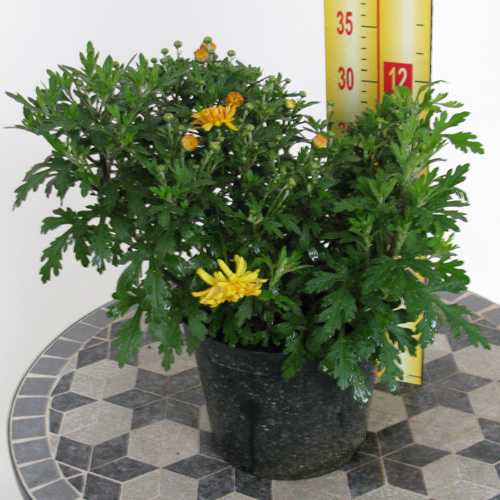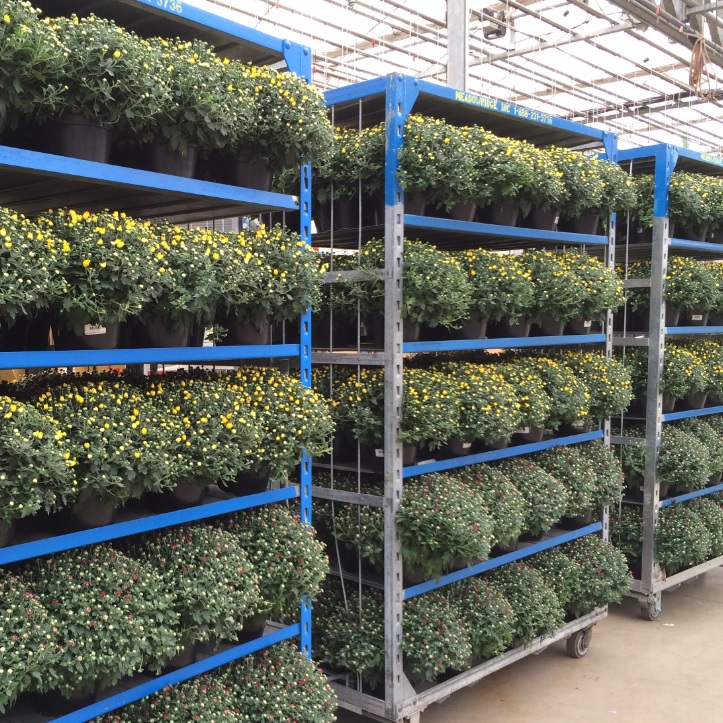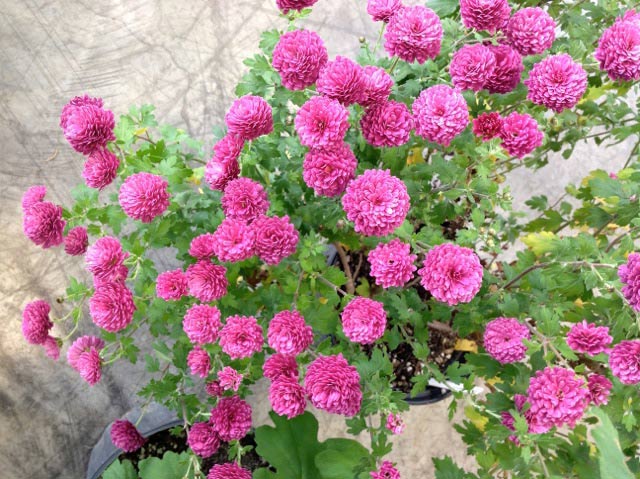Gorgeous mums in shades of red, yellow, orange, purple, and white pop up everywhere in the fall. I like to use them for autumn displays on my porch, along with dried cornstalks, gourds, and pumpkins. But by the following spring, my plants are usually reduced to clumps of dead stems. After checking in with a few mum-growing pros, I realized I was planting my mums too late. In fact, garden mums are fairly easy to grow, once you know the following common mistakes to avoid.
Planting chrysanthemum in the spring gives the perennial plant time to establish and adapt to its new garden home. You'll easily find mums in garden centers and nurseries in both fall and spring, but planning ahead is key to successful planting. Planting in the spring will also result in a bigger bloom the following season. Although some fall mums can survive winter if planted immediately, the odds are much better with spring-planted mums. Mums aren't exactly "pruned," but are instead pinched throughout the growing season. This helps the plant branch out, become fuller and offer more blooms.
When your plant reaches 6 inches tall in the spring, simply pinch off 1 inch of each shoot. Repeat this every 2 to 3 weeks until early summer.Deadhead spent blooms throughout the fall for an extended bloom time. Once the plant has died in the winter, resist cutting it back. Research reveals that allowing it to die back naturally over the winter produces a stronger plant. Simply clean up the dead stems and foliage in the spring. Finally, keep in mind that the fall mums sold in garden centers nowadays aren't the same kinds of plants sold 20 years ago, Enfield says.
Although garden mums are considered hardy to Zone 5, breeders have developed fall mums with big mounds of showy flowers. This has resulted, she says, in plants that may not be as cold hardy as in the past. So, if your fall-planted mums don't come back like true perennials, just treat them like annuals. Replace them with beautiful, fresh plants when you're ready to do your fall decorating and enjoy their colorful blooms for a season. Also known as hardy or Belgian mums, garden mums are sold in garden centers and nurseries, and they're perennials in USDA Zones 5 to 9.
But even when they're planted at the right time, they need a few other things, like excellent drainage. Enfield adds, "There's no guarantee they will survive the winter, particularly the further north you live in the U.S." If you plant hardy mums in the fall, they likely won't survive the winter.
Instead, you can try letting the plants go dormant in their pots and keeping them in a cold but frost-free indoor spot like a garage until the following spring. Then you can plant the mums outside in your garden once the soil has warmed up again. You should soon see new growth appearing from the roots if your plant is still alive.
Chrysanthemums often appear for sale at your local garden center or grocery store long before summer is over. But hold onto your pumpkin spice latte, should you buy these seasonal plants just yet? That's why a few potted mums perched on your porch seems like a no-brainer for transitioning from summer into the next season. But don't be in too much of a hurry if you want your plants to last. Even though retailers start selling mums well before fall begins, you may want to hold off on buying them just yet. Fertilizing your mums gives them an added boost of essential nutrients for the best growth.
The primary growth of chrysanthemum plant varieties takes place in spring and early summer. If you plant fall mums, wait to begin their fertilization until the spring. Fall fertilization can actually reduce the hardiness of chrysanthemums to survive cold winters. Fall flowers are your reward for planting mums in the spring and allowing them enough time after pinching or trimming to reach their potential. Just because you plant your mums late in the season, doesn't mean they won't overwinter. However, giving them a month or so before frost sets in to root into the soil well will make for a better yield of flowers.
An alternative to overwintering plants in a garden bed is to dig them up and put them in cold frames to ensure survival. If you live in a cold climate, it is best to leave the foliage on the plant, even after it has browned and died, to increase the plant's chance of surviving the winter. In spring, you can prune out the dead leaves before the new ones start to develop. Overwintering is more easily achieved in your garden if the mum bulbs are planted in the spring with plenty of time to root. If you're planting for next fall, the best time to plant mums is after the last frost. Since the roots of this plant are shallow, planting in the spring gives them enough time for growing a suitable root network.
To do their best, chrysanthemums should be planted in well-drained beds that receive at least six hours of sun daily. After they finish flowering, garden mums should be cut back far enough to remove all of the faded flowers (about one-quarter their height). If the winter stays very mild, some mums will produce a few more flowers.
In late January or early February, garden mums should be cut back to about three inches from the ground. They will stay dormant through the winter and are completely hardy here. New growth usually begins in February or early March when new shoots appear at the base of the old stem stubs.
It seems as soon as the air cools, signaling the coming of fall, garden centers begin showcasing full mounds of brilliant red, yellow, and violet flowers. Chrysanthemums, or mums, are a staple in fall gardens. Mums are a national symbol of fall abundance, and this herbaceous and hardy perennial is an easy addition to give a gorgeous pop of color in your fall garden landscape.
With a little understanding and a few simple tips, you can have a lush, beautiful fall chrysanthemum garden display to help celebrate the changing of seasons. Perennial mums, on the other hand, should be planted directly into your garden bed in the spring. Though they sometimes have smaller flowers, they'll provide autumn color to your garden year after year. However, they do require more maintenance throughout the summer. Like annual mums, you'll get the best blooms if they're planted in full sun, but they will tolerate partial shade. This encourages them to grow fuller and bushier, and flower later into the season.
Planting in the early spring will give the mums time to develop a good root system before blooming in the fall. It's not necessary to cut them back during the growing season, unless you want to reduce the height. Old-fashioned mums can reach heights of 24 to 36 inches but may be cut back by half in early July to reduce the height. They are excellent companions to other fall flowering perennials, such as salvias, asters, swamp sunflowers, Japanese anemones, sedums, and goldenrods. Plant the mums toward the back of perennial bed but allow space for them to spill over and intermingle with shorter companion plants. Good drainage during the winter months is a must, making sure that the roots are not inundated with cold and/or freezing water.
The base of the plant should be covered with 6 to 8 inches of soil, and all of the stems and stalks should be cut back to ground level. After the first frost, the gardener should apply 4 inches of mulch or straw over the top of the plant for the winter months. In colder temperatures, after November frost, cover with 12 inches of mulch. Good choices for mulch would be leaves or straw.
When the winter is over, the mulch material can be uncovered, and the plant will resume its growth. Purchasing locally-raised mums from a farm or nursery ensures that the varieties grown are well suited to your growing region. This is especially important if you will be transplanting the mum outdoors in your flower bed or displaying the potted plant outside.
Garden or hardy mums endure cooler outdoor temperatures better than florist mums, which are raised as indoor plants only. The chrysanthemum growing rate depends on many variables. Different varieties feature different growth rates and mature size. Plants grown from seed may take several years to reach their full growth potential.
Mums grown from already-established garden center plants and division have a head-start on the growing season. Taking proper care of mums through watering, fertilizing and pinching increases the fullness and growth capabilities of the plant. It can be tempting to plant mums closely together. Smaller, spring mums don't seem to fill out a garden space as well.
However, keep in mind that by fall, most properly planted mums will reach up to 3 feet in height and width. Like many perennials, mums will often become larger each year. Even if your flower bed looks a bit bare when you first plant your mums, in time it will fill in.Spacing mums properly is essential for plant health. Plants that are too crowded compete for nutrients, have root system issues, attract pests and suffer from disease.
Following the plant spacing directions for your chrysanthemum variety increases the health of your garden and protects your investment of time and money. Depending on the weather, Labor Day weekend can be a good time to put out your pots of mums and start planning your fall gardening and decorating. If it's still sweltering, though, you may want to wait a few weeks and put out your mums in mid- to late-September. When the weather turns cool and you can feel a hint of fall in the air, you know it's time to set out the pots. If you're shopping for plants at your local garden center, be sure to select mums with many closed bloom buds to ensure the plants will have longevity. I bought some potted mums from Home Depot in early October here in middle TN.
I kept deadheading them every other day, watered them, and kept them in full sun. After cutting my last bloom, they are all now blooming again. But now that they are blooming again, should I wait to put them away in the garage when frost first appears on the ground? Early spring is recommended … but with care, and continued mild weather, you might be ok. Cut off the dead stems and leaves when you see the first green shoots in spring. After the ground has frozen, spread 4 to 6 inches of mulch around the plant.
Mums can be grown as a perennial in most Midwest areas; check with a local garden center to see which varieties are best for your region. Mums are more likely to survive the winter if planted in spring rather than fall. Chrysanthemum is the common name for the Dendranthema grandiflora plant and flower, which thrives in U.S. Department of Agriculture plant hardiness zones 5 through 9.
They are perennial subshrubs in the family Asteraceae and are classified as eudicot angiosperms. The mum bulbs are almost perfectly rounded when fully mature. They grow in a range of colors, and most of the flowers are yellow, red, white or orange. Rarer cultivars include colors like burgundy or pink.
Oh, we haven't seen hardy mums in over a decade. Most "Garden Mums" are zone 6 -8 and aren't grown to be overwintered. They are hybridized to be an annual or at best a tender perennial. Occassionally they have small offsets that given the optimal conditions they will return.
Although they technically require only 6 hours of sunlight each day, the more light they receive, the better their growth, bloom and hardiness. Slight shade in hot, summer afternoons is appropriate in warmer gardening zones to prevent scorching.Mums bloom due to their photoperiodic nature. When the plant senses a change in the length of darkness in late summer, it begins to set buds. Planting near artificial lights, such as security lights or porch lights, can alter the bloom time of your mums.
If you don't pinch the growing tips of your garden mums, they'll bloom, but you'll have plants with long stems and fewer flowers. "Pinching to remove flower buds helps encourage the plant to branch and become fuller," Enfield says. "Stop pinching in early July (no later than mid-July) and allow the buds to form and flowers." Deadhead your garden mums in the fall, but leave the rest of the plant alone for as long as possible, Enfield advises.
Mums use their leaves to turn sunlight into energy for forming roots. Wait until the following spring to do any additional pruning, or until the stems die back to the ground. Then, cut the stems down to about an inch or so above the ground before new growth appears. These mums are actually perennials as long as they're properly planted and given the right care, so they make good choices for brightening up your fall garden. After a killing frost, clip faded flowers on established garden mums. Pile 3 to 4 inches of mulch over the entire plant, working it down between the stems.
Use something like straw or shredded bark that won't pack down. Many mums bloom throughout the fall months, but some species will provide blooms from late spring through the fall. In some cases, mum season varies according to the vagaries of the weather.
There are perennial varieties, and if those are planted early enough, they can usually be counted on to last through the cold months and bloom for years to come. Mums grow best with full morning sun, at least 5-6 hours daily. Water when the soil feels dry and add more mulch before your average first fall frost date. You can prune the mums in the late fall or in the spring. It's also adviced to pinch off the tops of stems in the spring to ecourage bushier growth and more flowers.
Add some compost and/or aged manure to the soil in the spring. Gardeners in areas where temperatures often dip below zero can lose even spring-planted hardy mums to winter, however. You can changes the odds in your favor by leaving the dead foliage on mums and asters instead of shearing them down for neatness. An Iowa State University study found that unpruned plants survive at much lower temperatures than those that were pruned; the foliage acted as extra insulation. Be sure to add 4 to 6 inches of mulch after the ground has frozen for even more protection. Asters can be planted in USDA Hardiness Zones 3 to 8 .




























